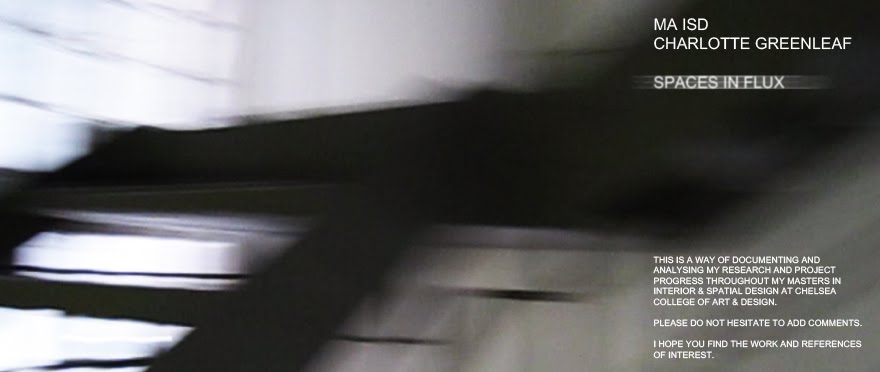My project seems to have an underlying, ongoing involvement with spiralling, twisting forms which encourage movement and flow. The following artworks stood out to me whilst researching.
Experiencing the Void, JDS Architects
I have previously mentioned Frank Lloyd Wright's Solomon R. Guggenheim Museum in New York, which consists of an inverted ziggurat with a unique spiralling ramp twisting down its interior. Central to this ramp is a huge empty void which leads up to a large skylight, flooding the space with light. The design of the building provides a unique setting for the presentation of contemporary art, driving visitors directly up to the top of the building in a lift, in order for them to view the art on a spiralling descent, whilst leaving prime viewing area as a huge void.

To mark the 50th Anniversary of the building the Guggenheim Museum invited artists, architects and designers to 'imagine their dream interventions in the space for the exhibition Contemplating the Void: Interventions in the Guggenheim Museum..... to leave practicality or even reality behind in conjuring their proposals for the space. In this exhibition of ideal projects, certain themes emerge, including the return to nature in its primordial state, the desire to climb the building, the interplay of light and space, the interest in diaphanous effects as a counterpoint to the concrete structure, and the impact of sound on the environment..... Contemplating the Void confirms how truly catalytic the architecture of the Guggenheim can be.' - Guggenheim website
The following proposal by JDS/Julien de Smedt architects is noteworthy, for its interaction with the architecture of the building into governing and enhancing how the viewer experiences and moves through the void space.

'Architecture turned into enjoyment and participation. Instead of contemplating the void we propose to experience it by letting a trampoline net spiral down the Rotunda space. The experience plays on Wright's original scenography for the Guggenheim to visit the exhibition downwards.'
- JDS/Julien de Smedt Architects
Spiral Staircase, Peter Coffin
I found this piece of work relevant to my research not only for its use of the spiral, but for the connection between content, form and media. This has been previously discussed in the work of Tacita Dean and the looped Spiral film I created. Peter coffin cleverly translates the notion of the spiral, encompassing a connection between content, form and media into the design of this piece of constantly circling and spiralling sculptural artwork.
Untitled (Spiral Staircase), Peter Coffin
2007
Aluminium and Steel
670.6 x 670.6 x 213.4 cm
'Coffin’s Untitled (Spiral Staircase) takes the idea of a simple architectural fitting to an absurd extreme. Reminiscent of Escher’s Infinite Staircase, Coffin’s winding steps are moulded into a circle, inexhaustibly twisting in impossible logic made real. By remodeling the steps, Coffin strips the staircase of its function, turning a thing which is normally engaged with physicality into a dizzying conceptual game. Through his humorous constructions, Coffin bridges art history and everyday experience, subverting the preconceptions of both.'
- Saatchi Gallery website
Conrad Shawcross

Loop System, 2006

Palindrome, 2007















 Insert: I have been thinking about the cameras and film/photographic footage for the device and following my research into the work of Simon Starling and Zilvinas Kempinas, I think it could be interesting to try to incorporate 35mm film into the project as a recording method to then be incorporated into the subsequent next stage of the project.
Insert: I have been thinking about the cameras and film/photographic footage for the device and following my research into the work of Simon Starling and Zilvinas Kempinas, I think it could be interesting to try to incorporate 35mm film into the project as a recording method to then be incorporated into the subsequent next stage of the project. 
























